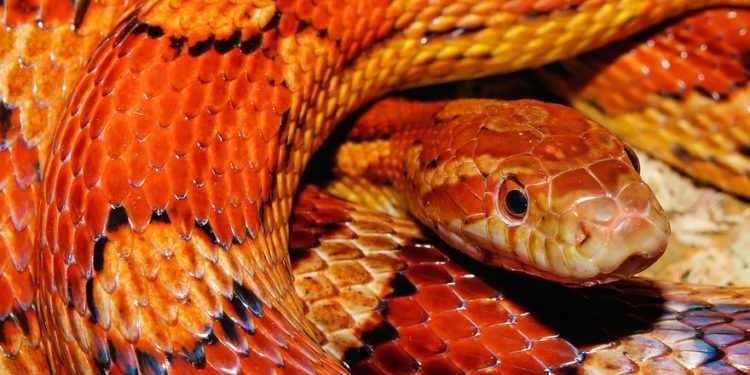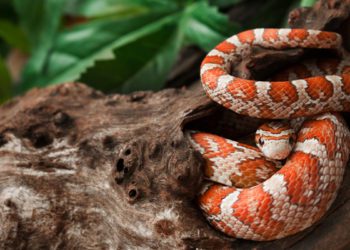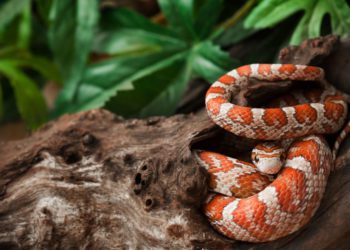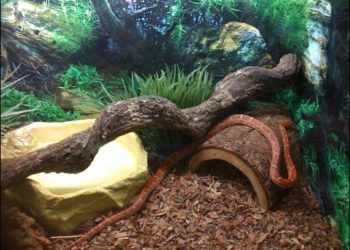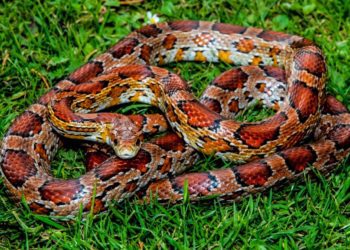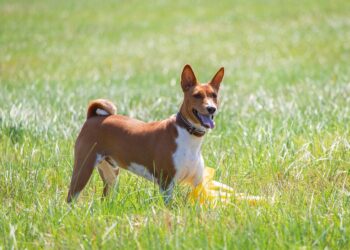Corn snakes, when they are in the wild, often preys on rodents and small animals. When in captivity the baby corn snakes are fed with pinky mice. These ones are very small mice, with pink bodies, as they do not have hairs grown on their body.
When they grow up and reach the juvenile stage, which is around 6 months, they are fed with juvenile mice. It takes them 7 to 10 days to digest the food and then you can feed it with another mouse.
When the corn snakes reach the mature age, they can eat the full-sized mice. Also, they are offered food once a week like before.
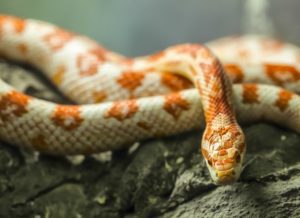
Contents
How many times a corn snake can eat in a week?
You can offer food twice within a week’s time, and probably a matured corn snake will eat that too. This system can work with baby corn snakes, as their growth rate is high and they consume a good amount of food. The metabolism in them also is increased ratio.
But in the case of a mature corn snake, this will not be a good idea. There can be times when you are leaving your pet with someone else and you do not want the other person to feed it. In that case, you can feed it twice a week and let it be without diet for another seven days. That way it will not be harmful to the snake. But this cannot be the regular practice. Feeding the snake two times a week will make it obese and that is not good for your pet.
Also, there are chances that the corn snake may vomit out the food as it will not be able to digest it. Snakes tend to eat the food that comes before them, so they can eat even if they are not hungry. But the extra food will be vomited out soon.
The size of the mice adequate for corn snake feeding:
The size of the mouse that is fed to the corn snake should be around one and a half times the size of the mid part of the snake’s body. The reason for this size parameter is, snakes do not chew their food but gobble it down. So the food that they eat will go inside their body in the original size and shape. That is why the parameter should be maintained to prevent the snake from choking.
Can you feed your corn snake every 3 days?
For a matured corn snake, feeding on a gap of three days is okay. The usual gap of feeding the corn snake is 3 to 5 days, and within that period of time, you should offer a full meal once to the matured corn snake. The amount of meal also differs with the feeding schedule. If you feed on every three days then the meal will be a small one. But when you are offering a heavy meal, it can be offered on a break of five days.
How long can you keep your corn snake without food?
Snakes and other reptiles have the practice of living without food for a long period of time. This habit is caused by the scarcity of foods in the area that they live in the wild. They can survive days without food by getting the energy from the stored fat in their body.
The need for hibernating is another example and causes the snakes to go without food for months. When it comes to corn snakes, they can survive without food for two to three months. The highest period that the corn snake goes without eating any food can be 90 days.
They do not get weak by this time as their body functions differently at this time period. This is a seasonal practice for them so you should not practice it regularly. In normal times they should be fed at a gap of 10 days maximum.
When a snake can be called overfed?
For first-time snake owners, this problem is pretty common. Snakes eat when they are hungry and that does not happen at particular times always. If you keep offering food to the snake thinking that it will do them good, then it may cause them obesity.
Maintaining regularity is good but that should not be overdone. Being too frequent in offering food to the corn snake may cause various kinds of problems. Even it can be fatal for corn snakes and they can die sooner than their natural lifespan.
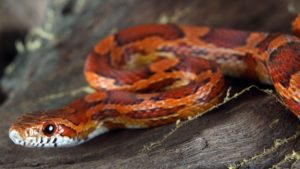
What is the outcome of overfeeding the corn snake?
When you are feeding the snake only within a day of the last meal, it can be truly dangerous for the snake. This food will not be digested as in most cases each meal takes a day to get fully digested and nutrients absorbed. So they will face indigestion and thus they will vomit out or throw up the excess food.
In the case of overfeeding done more than once a week, it will consume the food but will become fatter and that is an unhealthy sign for the snakes. This way its energy will be not used properly and its life cycle will also hamper.
How to understand that the corn snake is hungry?
As snakes eat only after the duration of few days, the owners need to remember the date on which they have given it food and next on which day it is supposed to eat. But in case you forget, then you have to check a few gestures of the snake,
If you try to play with the snake and attempt to keep the hand near the snake, then the pet may try to grab your hand by reaching it or try to strike at it. These are signs that may symbolize that the snake is in need of food and it is mistakenly thinking your hand to be its food.
Also if you are not providing it food for a longer duration, and the season is not adequate for hibernation, then you may see deterioration in the movement of the snake. It will move less and stay coiled up in its terrarium.
When does the corn snake refuse to eat?
Normally a corn snake does not refuse its food when it is the proper time to have a meal and the weather, as well as its health, is good. Some others may be the cause of its refusal to the food.
- If you are offering the food within 24 hours of the last meal consumption then it will surely not touch the food.
- They love to prey on the live creatures and that is what they do when they are in wild. So if you offer them dead mice instead of living ones, they may not touch it even if they are hungry.
- Shedding is the period when they do not feel much hungry. So if your corn snake refuses to eat food at the beginning of the shedding process or they are halfway in the process, they may not be interested in the food.
- Frozen mice, like the dead ones, do not attract them much. You cannot be sure if they will eat the frozen mice, which are not even thawed.
- Hibernating is another phase of time that is not ideal for food consumption. If you offer them food and they refuse, check the weather. Probably they are getting ready for hibernation period.
- Sudden illnesses can cause a lack of appetite in them. So if you find other reasons inadequate, then take it to the vet.
- Do not offer them larger food, as they will not try to eat that food. This is common in the case of a baby or juvenile corn snakes.
More:


